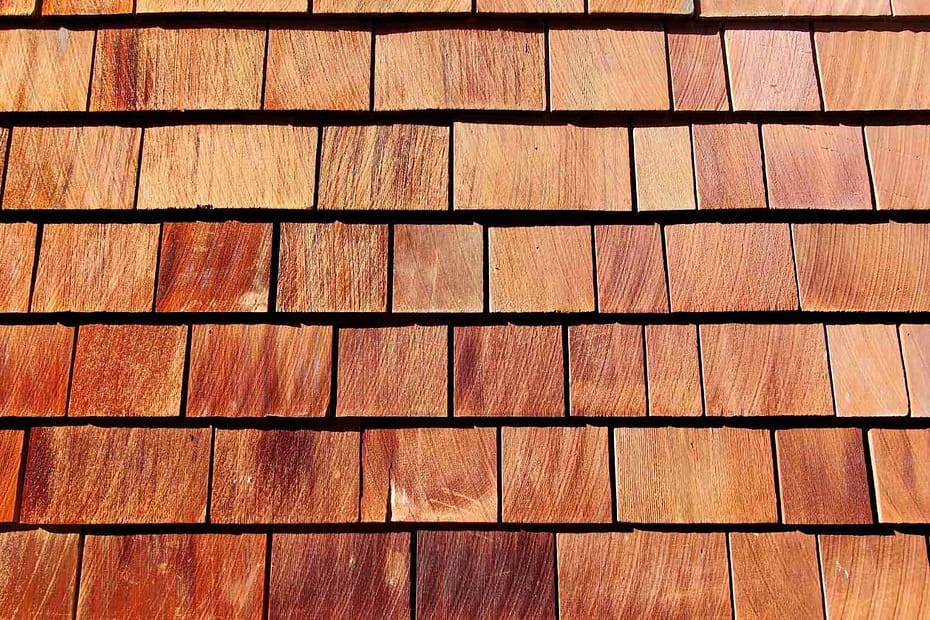Do you love the natural, rustic look of a wooden roof? If so, you’re probably researching cedar roofing. It’s a popular choice among homeowners because it ages beautifully, is insulating (keeping your home warm in the winter and cool in the summer) and has a long lifespan. But do you know the difference between cedar shakes and shingles?
If you’re wondering about the difference between cedar shakes vs cedar shingles, you’ve come to the right place. In this article, we’ll compare some of the things that make these two types of roofing materials similar, and what makes them different. Head over to our cedar
What are Cedar Shakes?
Cedar shakes preceded cedar shingles, and were heavily used on homes even in Colonial times. Shakes are made from cedar logs which are hand-sawn on two sides to create a tapered piece of wood that’s thicker on the top (often referred to as the “butt” end) and gradually becomes thinner.
Cedar shakes are thick, often ranging between ½ to ¾ inches or more. This thickness adds an incredible amount of durability to authentic cedar shakes, allowing them to successfully endure harsh winters and tough weather conditions. This is one of the reasons they’re commonly found atop colonial-style homes in New England, where they naturally age from orange to gray over time.
What are Cedar Shingles?
At first glance, cedar shingles and shakes may look very similar. However, when you take a closer look, the differences stand out. The key difference is in their production process. Shingles are machine-made, giving them a consistent size, shape, and thickness. They also don’t have the taper at the end that shakes do. Shakes, on the other hand, are hand-split, which results in a more unique and rough appearance for each piece. This hand-split nature gives shakes a rustic, uneven look, while shingles lay flat on the roof, much like asphalt shingles. Because cedar shingles are thinner and less rugged than shakes, they don’t insulate your home as effectively.

Differences Between Cedar Shakes vs Cedar Shingles
Even though they might look similar to people driving by, cedar shakes and cedar shingles are manufactured differently. But there are a few other differences you might notice as well. Cedar shakes can make your home look more rustic, but shingles are more uniform, and they’re installed in tidy-looking, straight rows. This gives your home a look that’s more similar to the traditional look of a shingled roof.
Cedar shakes are all different, since they’re cut from trees by hand. So you may notice each shakes has its own unique size and shape, as well as thickness. But in contrast, cedar shingles are manufactured so that each shingle is exactly the same as the others. And when it comes to protecting your roof from moisture leakage, cedar shakes require you to use an underlayment to protect your roof decking. This is because of gaps created by their lack of uniformity. Cedar shingles do not require any sort of underlayment. What’s more, cedar shakes are thicker, which makes them more insulating. They can keep out winter’s cold winds and deflect the sun’s hot rays in summer.
Similarities Between Cedar Shakes vs Cedar Shingles
Even though there are several differences between shakes and shingles, to the average person they’re very similar. But there are some things you can count on to be pretty similar no matter which type of cedar material you choose for your roof. Both types of wood have similar maintenance requirements (see: How to Maintain a Cedar Shake Roof), and they both start off orange when they’re installed, but over the years they slowly age to a silvery gray color.
If you’re looking for a rustic-looking roof that makes you think of those classic New England-style cottages, you might want to consider using cedar shakes on your home. But if it’s a more elegant, uniform look you’re going for, cedar shingles make a great choice, and they often last longer than asphalt shingles. Before you make a final decision, though, find a roofer who has experience with cedar roof installation.
Fact Checked by Christin Perry 8/30/2024

